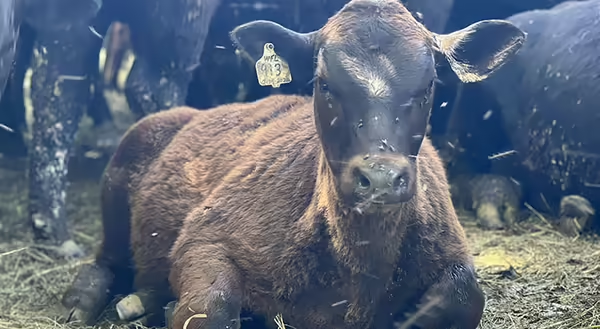
Authored by Ashley Cooney, Intern, University of Illinois Orr Beef Research Farm.
It's the middle of fly season and a good time to put a fly control program into place or to evaluate how effective your current fly control program is. Flies can cause up to $1 billion in revenue loss, so it is vital to have a good fly control program. The loss in revenue is caused when flies found on cattle are over the economic threshold. The economic threshold, or the number of flies that cause negative effects on cattle, is 100 flies per side for a cow and 50 flies per side for a calf. Negative effects from too many flies include interrupted grazing, lower performance, lower average daily gain, and pinkeye propogation.
The flies that are most commonly found on cattle are horn flies, face flies, stable flies, and house flies.
- Horn flies: found on the shoulders, back, and belly of cattle. They can eat 20-30 blood meals per day. They lay their eggs in fresh manure
- Face flies: found on the eyes, mouth, and muzzle of cattle. They feed on secretions and are vectors for pink eye
- Stable flies: found on the legs of cattle. The economic threshold of stable flies is 5/leg. They cause cattle to stomp their feet and switch their tails
- House flies: bite and feed on cattle's blood. They are a vector for anaplasmosis
There are different types of control that producers can use to create a fly plan. The types of controls can be fly tags, feed-through, oiler, pour-on, and direct spray.
- Fly tags: Ear tags that are coated in insecticide. They target face flies only, have a shorter lifetime, and can be more expensive. There are many options for rotational use with fly tags.
- Feed-through: A feed additive or supplement given in a free choice setting that contains fly preventatives. It needs to be fed 30 before fly season starts to be effective and only prevents horn flies. It is inexpensive, has no labor involved, and breaks the life-cycle of the fly.
- Oiler: A back rubber filled with fly control chemicals that cattle can rub against. It will have to be refilled and in a location where cattle will be forced to use them, whether that be a in a gateway, around a mineral feeder, or any other area that cattle frequently go to. It controls face flies and is low labor for re-applying fly control.
- Pour-on: This is an insecticide that is poured on to the back of a cow. The amount of time that it lasts is variable, so it must be re-applied frequently and is labor expensive. It can prevent some internal parasites on top of flies. This is a good to be used as part of a component in a fly control program. It can be used to control the horn flies and then you can use fly tags to control face flies.
- Direct spray: This is an insecticide that is sprayed onto a cow's back, belly, or legs. It can be very labor intensive. It will immediately decrease the fly load and is very effective for flies everywhere on a cow. The direct spray is intermediate for expenses.
When creating a fly control program or evaluating one for its effectiveness, it is important to consider resistance. The best thing that producers can do to avoid flies becoming resistant is to rotate the classes of chemicals used. There are two major classes of chemicals that should be rotated to avoid resistance: pyrethroid and organophosphate. Newer classes are being developed and they should be considered as part of your rotation. Rotating the class of chemical used in fly tags every year will help reduce resistance. You should also delay treating the cattle for flies until the flies have reached the economic threshold (200 flies on cows, 100 flies on calves). Producers should also consider using fly control products during the late fly season which will help cut back on the number of larvae that will go underground during the winter. Finally, in the fall, producers should remove the fly tags from the cattle.
A fly control program can save producers money and help cattle stay healthy. A good fly control program will be designed to reduce fly populations, repel existing fly loads, and decrease larvae and breeding areas.
More information available here